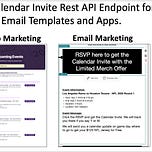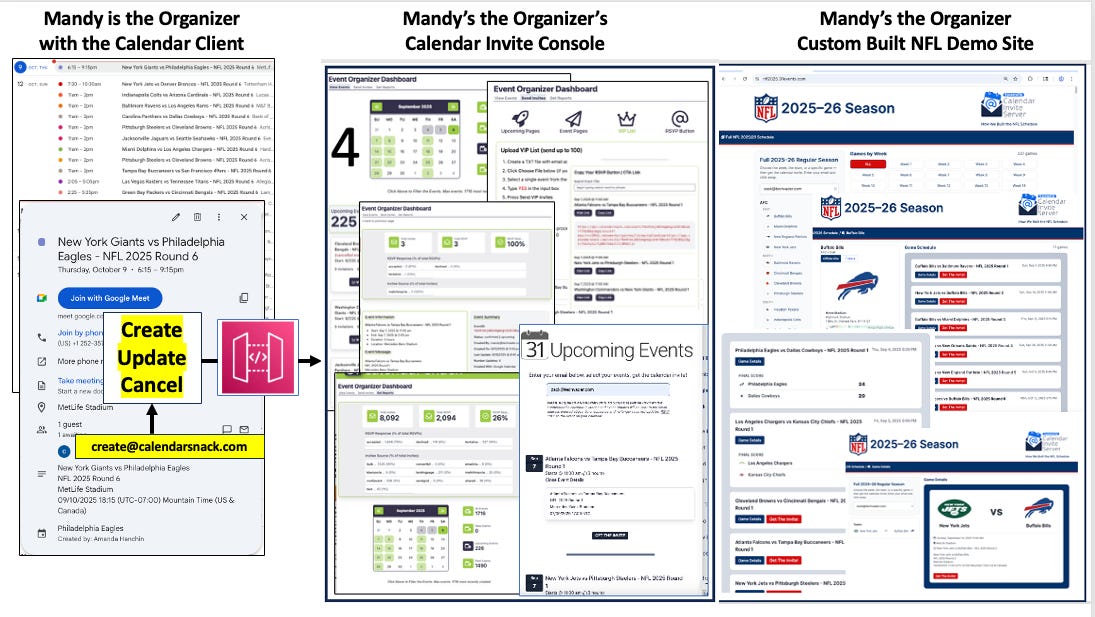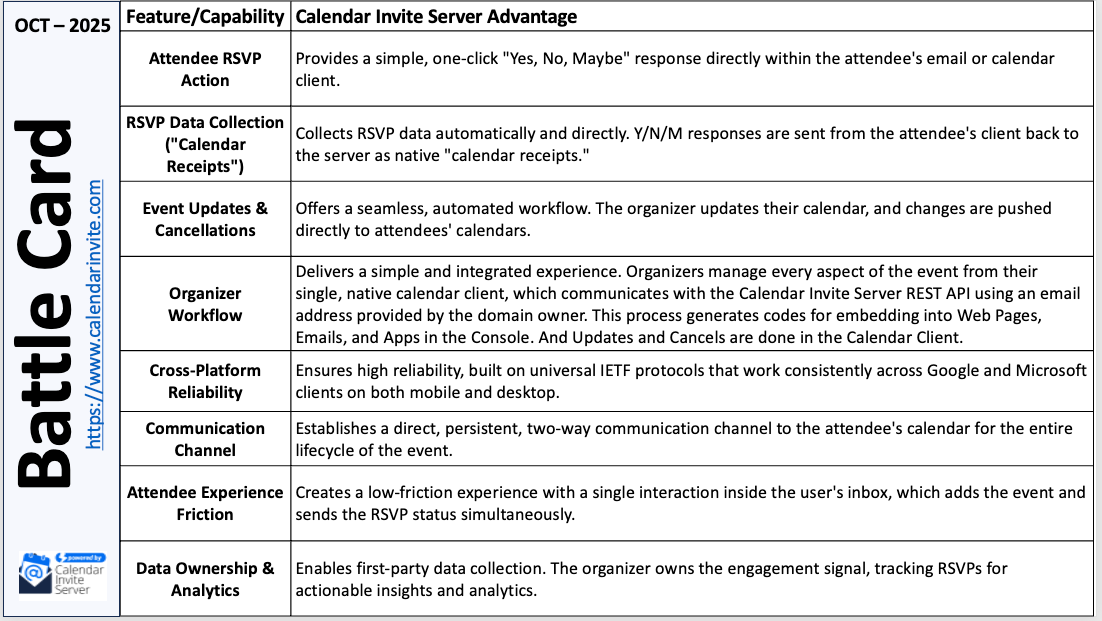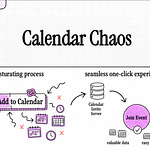The ubiquitous “Add to Calendar” button is a broken, high-friction relic that costs businesses valuable data and engagement.
The Calendar Invite Server replaces this failed system with a native, API-driven messaging pipeline, transforming every attendee’s calendar into an owned, persistent communication channel and unlocking a new standard for event-driven marketing.
1.0 The Market Opportunity: Moving Beyond the “Add to Calendar” Button
1.1 Introduction: The Inefficiency of Current Event Engagement Tools
The current landscape of digital event promotion is defined by a collection of ubiquitous but fundamentally flawed tools. While “Add to Calendar” buttons and RSVP forms are widespread, they represent a fragmented, high-friction, and inefficient system for both event organizers and their attendees. This disconnect is more than a minor inconvenience; it signifies a missed strategic opportunity. The inability to establish a direct, persistent communication channel through the one application every professional uses daily—their calendar—results in lost data, poor user experiences, and a significant administrative burden. Solving this core inefficiency is the key to transforming event promotion from a one-time data drop into a valuable, ongoing messaging pipeline.
1.2 Analysis of Legacy System Failures
The incumbent “Add to Calendar” button, combined with a separate “RSVP Form,” is not a proper system, but rather a bolt-on workaround plagued by inherent failures. A critical analysis reveals a methodology that is unreliable, difficult to manage, and frustrating for users.
Fragmented User Experience: Attendees face a multi-step, high-friction process. They must first click a platform-specific button (e.g., Google, Apple, Microsoft), download a file, and then are often redirected to a separate landing page to fill out a form, creating multiple points of failure and user drop-off.
Disconnected Data Collection: This method fails to collect native RSVP data. Instead, it relies on a separate web form to capture responses. This “bolt-on” approach is indirect, requires manual data reconciliation, and provides no real-time connection to the attendee’s actual calendar status.
Inability to Manage Event Changes: The legacy workflow has a nonexistent process for handling event updates or cancellations. Organizers are forced to send a new email blast, hoping attendees see it, manually delete the old event, and add the new one. This often leads to user confusion and “ghost” events remaining on calendars.
Complex Organizer Workflow: The process for organizers is equally fragmented. It requires logging into multiple vendor platforms to generate buttons, create and manage forms, and then attempting to reconcile the disparate data. Any change to the event forces the organizer to repeat this complex and time-consuming process.
Poor Reliability: The system is prone to user error and demonstrates low cross-platform reliability. Inconsistent file handling across different calendar clients and operating systems often causes the “Add to Calendar” function to fail, resulting in a broken user experience.
1.3 Concluding Transition
The market is clearly in need of a modern, integrated solution that replaces these disjointed legacy tools. The Calendar Invite Server is designed to be that solution.
2.0 The Solution: The Calendar Invite Server (CIS) Messaging Pipeline
2.1 Introduction: A New Paradigm for Calendar Communications
The Calendar Invite Server (CIS) is the definitive solution to the deep-seated problems of legacy event tools. It is not an incremental improvement but a fundamental shift in strategy, transforming the calendar from a static scheduling utility into a direct, two-way messaging pipeline. CIS allows organizers to send, track, update, and cancel native calendar invites directly from web pages, email templates, or applications. By owning this channel, organizations can not only manage event logistics but also execute advanced strategies, such as pushing promotional offers or new product launch details directly into existing calendar entries, extending the communication lifecycle indefinitely.
2.2 Core Architecture and Workflow
At its core, the Calendar Invite Server is a REST API-based system designed to mimic the functionality of a legacy calendar server like Google or Microsoft. It operates through a messaging pipeline composed of three core processor components that handle the entire event lifecycle.
Inbound Processor: This processor is the entry point for all event data. An organizer creates or edits an event in their native calendar client (e.g., Google, Outlook) and sends the invitation to a designated email address. The Inbound Processor ingests this email, disassembles the calendar invite data, and stores it in a database, assigning a unique ID and linking it to the organizer’s email address.
Outbound Processor: This processor is triggered via the CIS REST API. When a user clicks a button on a webpage, in an email, or within an app, the API calls upon the stored event data. The Outbound Processor reassembles this data into a native calendar invite and sends it directly to the attendee. Crucially, it also requests and tracks the “calendar receipts”—the industry term for the automated Yes, No, or Maybe responses sent directly from the attendee’s calendar client.
Update/Cancel Processor: This component automates the management of event changes. When an organizer edits an event (changing the date, time, location, or adding a promotional message) in their native calendar client, the change is captured by the Inbound Processor. The system then automatically pushes a revised native calendar invite. Updates are sent to attendees who responded ‘Yes’ or ‘Maybe,’ while cancellations are sent to all original invitees to ensure the event is removed from every calendar.
2.3 The Organizer’s Calendar as the Single Source of Truth
A cornerstone of the CIS strategy is leveraging the organizer’s native calendar client (Google, Outlook, etc.) as the primary interface for creating, updating, and deleting events. This decision is based on a simple but powerful reality. With a combined 750 million daily users, these clients represent a massive, globally adopted user base that requires minimal to no additional training. They are robust, feature-rich, and provide sophisticated multi-language support and advanced viewing options. By using the organizer’s calendar as the system of record, CIS eliminates the need for a new, complex interface. It allows organizers to work within the familiar environment they already use every day.
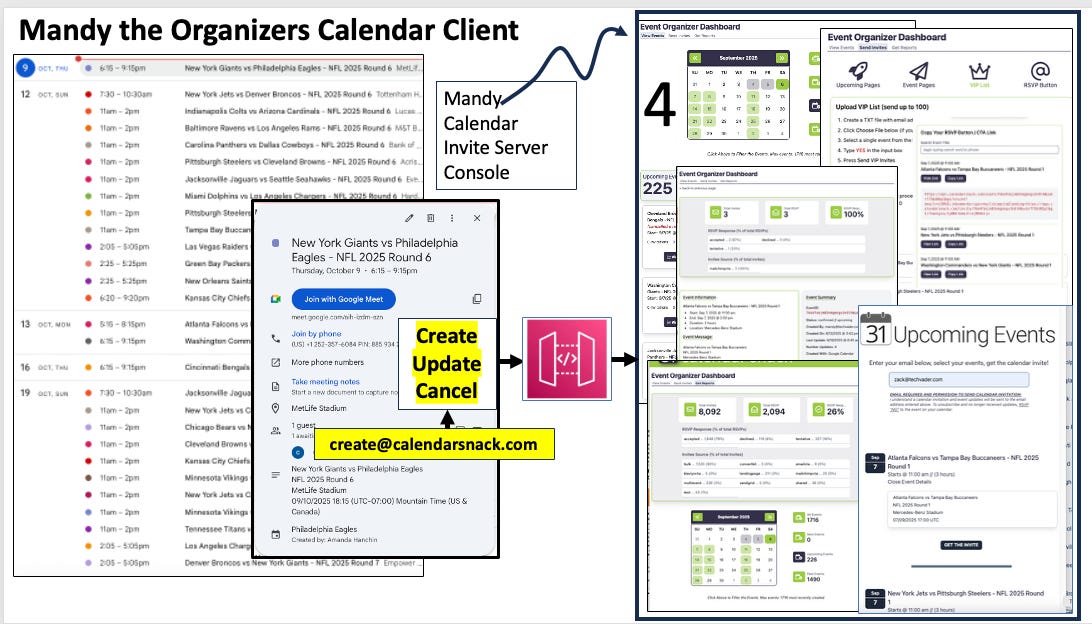
2.4 Concluding Transition
This elegant architecture provides the technical foundation for a superior event communication system. The actual value, however, becomes most apparent when directly comparing its capabilities against the incumbent legacy workflow.
3.0 Core Value Proposition & Competitive Differentiation
3.1 Introduction: Defining a Superior Standard
This section clearly articulates the unique value and defensible competitive advantages of the Calendar Invite Server. The primary comparison is not with another software product, but with the inefficient, fragmented, and unreliable legacy workflow that currently dominates the market. CIS establishes a new, superior standard for event-based communication by directly addressing every failure point of the incumbent method.
3.2 Comparative Analysis: Native Calendar Invite API vs. Legacy “Add to Calendar”
3.3 Concluding Transition
The overwhelming advantages of this native, API-driven approach create a powerful value proposition. This technology is poised to deliver transformative results for specific market segments that will benefit most from its capabilities.
4.0 Ideal Customer Profiles (ICPs)
4.1 Introduction: Targeting High-Value Segments
The Calendar Invite Server technology is not a one-size-fits-all solution. It is specifically designed for customer profiles that require scalable, reliable, and data-rich communication for event-driven marketing and operations. Our go-to-market strategy targets four primary markets where CIS can deliver immediate and significant value by addressing their unique, large-scale needs.
4.2 Defined Customer Profiles
Profile 1: Large Digital Marketing Agencies
This profile includes agencies that manage extensive web properties and numerous brands. Their primary need is to conduct sophisticated marketing campaigns at scale. CIS is compelling for this segment because it allows them to solve the “disconnected data collection” problem by embedding dynamic event schedules on websites and, critically, conducting A/B testing with native calendar invites to measure engagement far more accurately than web form submissions.
Profile 2: Software OEMs (Marketing & Transactional)
This segment comprises software companies seeking to integrate native calendar functionality directly into their platforms. Key examples include marketing automation platforms (HubSpot, Mailchimp, Klaviyo), communication APIs (Twilio), and ERP systems (SAP). This allows them to solve the “disconnected data collection” problem for their own customers, offering native calendar receipts as a value-add feature within their platform instead of relying on inefficient web form workarounds for both marketing promotions and transactional notifications like invoice reminders.
Profile 3: Single OEM IP Buyer
This profile represents a single, strategic entity seeking to acquire the entire technology stack. The goal for this buyer would be to fully commercialize the platform, reselling it across a wide range of industries and vertical markets. The value lies in owning a mature, proven technology that solves a universal business problem, allowing for rapid market penetration and diverse revenue streams.
Profile 4: AWS Partner
This profile is a partner operating within the Amazon Web Services ecosystem. The strategic goal is to package the Calendar Invite Server and list it on the AWS Marketplace. This allows the partner to sell per-server licenses directly to existing AWS customers, a highly compelling channel for targeting the millions of businesses that already use AWS Simple Email Service (SES) and want a more powerful way to engage their audience.
4.3 Concluding Transition
These distinct customer profiles require flexible product offerings tailored to their technical and business needs—the following section details how the Calendar Invite Server is packaged to serve these target markets effectively.
5.0 Product Packaging and Deployment Model
5.1 Introduction: Flexible Solutions for Target Customers
To meet the diverse needs of our ideal customer profiles, the Calendar Invite Server is packaged into distinct components that provide maximum deployment flexibility. The product is separated into a core back-end messaging pipeline and a user-facing front-end console, allowing customers to deploy the pieces that fit their specific use case and existing infrastructure.
5.2 Product Components
Back-End Package: The Core Messaging Pipeline. This is the engine of the solution, delivered as an AWS CloudFormation template. It includes the three core processors—Inbound, Outbound, and Update/Cancel—that power the entire event lifecycle. The template leverages a suite of powerful AWS services, including SNS, SQS, SES, SES RAW, Route 53, API Gateway, Lambda, DynamoDB, S3, CloudFormation, and CloudWatch. The package is delivered via GitHub and includes comprehensive documentation and deployment instructions.
Front-End Package: The Organizer & Domain Owner Console. This is the user-facing application built in Vue.js, providing a dashboard and management tools for organizers. It communicates with the back-end APIs to allow users to view event data, track RSVPs, and manage their calendars. The front-end package comes with an installer for easy deployment on AWS or another Content Delivery Network (CDN).
5.3 Deployment and Security Model
The Calendar Invite Server is delivered as a “you own it and you run it“ solution. This deployment model is a key differentiator, as it means the entire technology stack is deployed directly within the customer’s own AWS account. This approach provides customers with complete control over their infrastructure, data, and security.
The security model is based on AWS Serverless Security Best Practices. By deploying into the customer’s environment, the solution inherits their existing security posture, and the customer maintains full ownership and control over all data, including personally identifiable information, ensuring compliance with their internal governance policies.
5.4 Concluding Transition
This flexible packaging and secure deployment model enables us to reach our target customers through multiple high-potential strategic channels, as outlined in the final section.
6.0 Strategic Go-to-Market Channels
6.1 Introduction: Reaching Our Ideal Customers
Our go-to-market strategy utilizes a multi-channel approach designed to reach our ideal customer profiles where they operate. The strategy leverages existing, large-scale technology ecosystems and directly addresses high-value, untapped market opportunities with tailored solutions. Each channel is selected for its ability to deliver the Calendar Invite Server to customers who will benefit most from its unique capabilities.
6.2 Primary Market Channels
AWS Marketplace. This is the most natural-fit GTM channel for the Calendar Invite Server. By listing the product on the AWS Marketplace, we can directly target the 25 million+ users of AWS Simple Email Service (SES). This ecosystem is rich with software OEMs, digital agencies, and AI companies already building on the AWS stack, making them ideal customers for a per-server license model.
Large Web & Domain Hosting Entities. This channel focuses on the hundreds of millions of domain owners globally. We will enable large hosting entities to offer their own branded instance of the Calendar Invite Server. This allows their customers to run a powerful RSVP service tied directly to their domain name, leveraging the AWS SES service that many of them may already be using.
Direct OEM Integration - Email Marketing & Newsletter Platforms. This strategy involves providing API code that allows for the direct embedding of calendar invites into the Call-to-Action (CTA) buttons of hundreds of email marketing providers. A key untapped market within this channel is newsletter platforms like Bee Hive and Sub Stack. By enabling millions of creators to directly send, track, and update calendar invites for promotions and brand offers, the platform provides a powerful tool for subscriber retention and engagement.
Vertical-Specific Custom Deployments This channel targets high-value opportunities that require custom-built websites for managing complex schedules. This is particularly relevant for the Sports industry (NFL, NBA, MLB, NHL) and large-scale Technology Conferences. By creating bespoke, embeddable schedule sites powered by CIS, we can help brands create powerful fan engagement platforms and communication tools.
6.3 Concluding Statement
The market opportunity is immense. The simple “Add to Calendar” button is a relic of a disconnected era, and organizations are ready for a more innovative way to engage with their audiences. By leveraging the power of native calendar clients and a robust serverless architecture, the Calendar Invite Server provides a simple, scalable, and strong way for millions of event organizers to finally create a direct and persistent messaging pipeline to their customers’ calendars, transforming a static schedule into a dynamic, owned communication channel.


